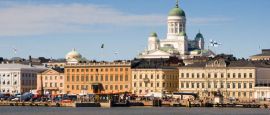Finland History, Language and Culture
History of Finland
Finland’s first settlers lived in the region around 120,000-130,000 years ago. During the Iron Age, the land was inhabited by the Finnish Proper, Tavastian, Karelian, and Sámi cultures. The settlers spoke dialects belonging to the Finno-Ugric group (except Sámi who speak several distinct Uralic languages), quite different from the Indo-European languages spoken throughout most of the rest of Europe.
After centuries of violent conflict in the region, Finland ended up under Swedish rule around the 14th Century until 1809 when Alexander I of Russia invaded. Finland became a Grand Duchy of Russia and the capital was moved from Turku to Helsinki, closer to St. Petersburg and further away from Swedish influence. The period of Russian rule was marked by famine – the 1866-1868 famine killed 15% of the population in Finland – but also a strong nationalist movement, popular after the national epic Kalevala was compiled from folk stories dating back thousands of years. Progressive movements like women’s suffrage gained traction quickly; Finland was the first country in the world to implement full universal suffrage in 1906. In the following year the Finnish people elected the world’s first female members of parliament. In 1917, Finland finally gained independence from Russia.
Under the Paris Peace Treaties 1947, the Finns were forced to cede most of their Karelian territory to the USSR and pay reparations, resulting in more than 400,000 Karelian refugees being displaced. Since the fall of the Soviet Union there has been some debate over whether Russia should return Karelia to Finland, but this has not yet led to any formal discussions between the two powers.
Since joining the EU in 1995, the focus in Helsinki has switched towards Europe, and also the development of relations with the newly independent Baltic states of the former USSR, with whom there are cultural and linguistic links.
For decades, Finnish domestic politics was dominated by the Social Democratic Party (SDP) and the Centre Party (known as 'Kesk'), which led a long series of coalition governments. In recent years, however, the political landscape in Finland has shifted, with the emergence of the right-wing National Coalition Party (Kokoomus, referred to as 'Kok') and the populist far-right ‘True Finns’ party, both of whom entered a coalition alongside the Centre Party in 2015, booting the long-standing SDP’s into opposition.
Social Democrat Tarja Halonen, Finland’s first female president, took office at the beginning of 2000 and remained there until 2012. National Coalition Party’s Sauli Niinistö took over the role has since taken over the role.
Did you know?
• Finland has the highest number of heavy metal bands per capita in the world. There are around 2,800 heavy metal bands in Finland.
• Another thing Finland has in abundance? Saunas. It is estimated there are around two million of them serving a population of 5.5 million – that’s more than one for every three people.
• The average Finnish person consumes 12kg of coffee per year (compared to an annual world average of around 1.3kg per person). They also drink more milk per capita than anywhere else in the world.
Language in Finland
There are two official languages: Finnish, mother tongue for 91.6% of the population, and Swedish, first language of 5.5% of the population. Swedish Finns have a distinct cultural identity and often speak English more fluently than they speak Finnish. The Finnish language is related to only Estonian and Hungarian. Around 2,000 people in Lapland speak one of the dialects of the Sámi language, while Karelian dialects still survive amongst older people in the east of the country. English is taught as the first foreign language.
- Beer = Olut
- Closed = Suljettu
- Danger = Vaara
- Do you speak English? = Puhutko englantia?
- Doctor = Lääkäri
- Eight = Kahdeksan
- Eighty = Kahdeksankymmentä
- Entrance = Sisään
- Exit = Ulos
- Fifty = Viisikymmentä
- Five = Viisi
- Forty = Neljäkymmentä
- Four = Neljä
- Friday = Perjantai
- Goodbye = Näkemiin
- Hello = Hei/Moi
- Hotel = Hotelli
- How are you? = Mitä kuuluu?
- How much does it cost? = Mitä tämä maksaa?
- I'm very well = Kiitos hyvää
- I don't understand = En ymmärrä
- I feel ill = Olen sairas
- Menu = Ruokalista
- Monday = Maanantai
- My name is = Nimeni on …
- Nine = Yhdeksän
- Ninety = Yhdeksankymmentä
- No = Ei
- One = Yksi
- One Hundred = Sata
- One Thousand = Tuhat
- Open = Avoinna
- Please = Ole kiltti
- Restaurant = Ravintola
- Saturday = Lauantai
- Seven = Seitsemän
- Seventy = Seitsemankymmentä
- Six = Kuus
- Sixty = Kuusikymmentä
- Sunday = Sunnuntai
- Ten = Kymmenen
- Thank you = Kiitos
- Thirty = Kolmekymmentä
- Three = Kolme
- Thursday = Torstai
- Today = Tänään
- Toilets = Vessa / WC
- Tomorrow = Huomenna
- Tuesday = Tiistai
- Twenty = Kaksikymmentä
- Two = Kaksi
- Wednesday = Keskiviikko
- Where is ? = Missä on ...?
- Wine = Viini
- Yes = Kyllä




 You know where
You know where